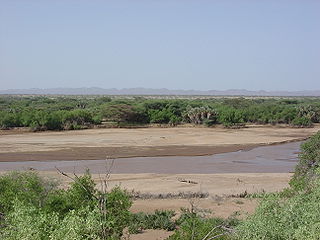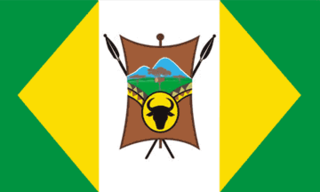
The Kerio River is a river in Turkana County, Kenya. It flows northward into Lake Turkana. It is one of the longest rivers in Kenya, originating near the equator.
The Nilotic peoples are people indigenous to the Nile Valley who speak Nilotic languages. They inhabit South Sudan, Sudan, Ethiopia, Uganda, Kenya, the eastern border area of Democratic Republic of the Congo, Rwanda, Burundi and Tanzania. Among these are the Burun-speaking peoples, Teso people also known as Iteso or people of Teso, Karo peoples, Luo peoples, Ateker peoples, Kalenjin peoples, Karamojong people also known as the Karamojong or Karimojong, Datooga, Dinka, Nuer, Atwot, Lotuko, and the Maa-speaking peoples.

The Samburu are a Nilotic people of north-central Kenya. Samburu are semi-nomadic pastoralists who herd mainly cattle but also keep sheep, goats and camels. The name they use for themselves is Lokop or Loikop, a term which may have a variety of meanings which Samburu themselves do not agree on. Many assert that it refers to them as "owners of the land" though others present a very different interpretation of the term. Samburu speak the Samburu dialect of the Maa language, which is a Nilotic language. The Maa language is also spoken by other 22 sub tribes of the Maa community otherwise known as the Maasai. Many Western anthropologists tried to carve out and create the Samburu tribe as a community of its own, unaffiliated to its parent Maasai community, a narrative that seems that many Samburu people today hold. There are many game parks in the area, one of the most well known is Samburu National Reserve. The Samburu sub tribe is the third largest in the Maa community of Kenya and Tanzania, after the Kisonko (Isikirari) of Tanzania and Purko of Kenya and Tanzania.

The Kalenjin are a group of tribes indigenous to East Africa, residing mainly in what was formerly the Rift Valley Province in Kenya and the Eastern slopes of Mount Elgon in Uganda. They number 6,358,113 individuals per the Kenyan 2019 census and an estimated 273,839 in Uganda according to the 2014 census mainly in Kapchorwa, Kween and Bukwo districts.

The Pokot people live in West Pokot County and Baringo County in Kenya and in the Pokot District of the eastern Karamoja region in Uganda. They form a section of the Kalenjin ethnic group and speak the Pökoot language, which is broadly similar to the related Marakwet, Nandi, Tuken and other members of the Kalenjin language group.

The Turkana are a Nilotic people native to the Turkana County in northwest Kenya, a semi-arid climate region bordering Lake Turkana in the east, Pokot, Rendille and Samburu people to the south, Uganda to the west, to the South Sudan and Ethiopia to the north.
Lébamba is a small town in south-western Gabon. It is the capital of Louetsi-Wano Department in Ngounié Province. It lies along the N6 road, 38.3 kilometres northeast of Ndendé. A Catholic Mission has long been established in Lébamba.
Loiyangalani is a small town located on the southeastern coast of Lake Turkana in Kenya. The town has a population of 5,117. Loiyangalani means "a place of many trees" in the native Samburu tongue. It is home to Rendille and Elmollo People but now has other Kenyan communities like Turkana people, Luo, Meru, and Somali. It was founded near a freshwater spring in the 1960s where the Rendille and El Molo people live. Its main industries include fishing, tourism and gold panning. It is a popular tourist destination in Northern Kenya, as the surrounding El Molo and Turkana villages offer unique experiences.

Turkana County is a county in the former Rift Valley Province of Kenya. It is Kenya's second largest county by land area of 98,597.8km2 followed by Marsabit County with an area of 71,597.8km2. It is bordered by the countries of Uganda to the west; South Sudan and Ethiopia, including the disputed Ilemi Triangle, to the north and northeast; and Lake Turkana to the east. To the south and east, neighbouring counties in Kenya are West Pokot, Baringo and Samburu Counties, while Marsabit County is on the opposite shore of Lake Turkana. Turkana's capital and largest town is Lodwar. The county had a population of 926,976 at the 2019 census.

West Pokot County is a county in Kenya. Its capital and largest town is Kapenguria. The county covers an area of approximately 9,169.4 square kilometers and stretches a distance of 132 kilometers from north to south.
Kacheliba Constituency is an electoral constituency in Kenya. It is one of the four constituencies of West Pokot County. The constituency has six wards, which are represented by Members of County Assembly at the West Pokot County Assembly in Kapenguria. The constituency was established before the 1988 elections in order to cater for the interests of the Kara-Pokot community following years of under representation. The constituency was created by the Electoral Commission of Kenya through a publication in the Kenya Gazette.

Cordia sinensis is a species of flowering tree in the borage family, Boraginaceae. The species’ range extend from South Africa, through East Africa, Madagascar, West Africa and the Middle East to the Indian Subcontinent and Eastern Indochina. There is also a disjunct native population in Senegal. The species has become naturalised in Eastern Australia. Common names include grey-leaved saucer berry, grey-leaved cordia, marer, mnya mate, mkamasi and tadana.

The Red Maasai is a breed of sheep indigenous to East Africa. True to its name, the breed is kept by the Maasai, though both pastoralists and smallholder farmers in Kenya, Tanzania, and Uganda keep Red Maasai flocks.

Sub-counties, also known as Districts, are the decentralised units through which government of Kenya provides functions and services. At national level, sub-counties take a more administrative function like security, statistical purposes, provision of government services, etc. Even though the sub-counties are divisions of counties, powers to create new national sub-counties lies with the national government. As of 2023, there are 314 sub-counties, compared to 290 constituencies. A deputy county commissioner is appointed by the state to lead each sub-county. The sub-counties are further divided into divisions, locations and sub-locations.
Baringo District was an administrative district in the Rift Valley Province of Kenya. Its capital town was Kabarnet. The district had a population of 264,978 and an area of 8,646 km2 (3,338 sq mi). The district was created by the colonial government. In 2013, the district ceased to exist and Baringo County was formally established.
The Kalenjin people are an ethnolinguistic group indigenous to East Africa, with a presence, as dated by archaeology and linguistics, that goes back many centuries. Their history is therefore deeply interwoven with those of their neighboring communities as well as with the histories of Kenya, Uganda, Tanzania, South Sudan, and Ethiopia.

The Savanna Pastoral Neolithic is a collection of ancient societies that appeared in the Rift Valley of East Africa and surrounding areas during a time period known as the Pastoral Neolithic. They were South Cushitic speaking pastoralists who tended to bury their dead in cairns, whilst their toolkit was characterized by stone bowls, pestles, grindstones and earthenware pots.

The Elmenteitan culture was a prehistoric lithic industry and pottery tradition with a distinct pattern of land use, hunting and pastoralism that appeared and developed on the western plains of Kenya, East Africa during the Pastoral Neolithic c.3300-1200 BP. It was named by archaeologist Louis Leakey after Lake Elmenteita, a soda lake located in the Great Rift Valley, about 120 km (75 mi) northwest of Nairobi.
Mutai is a term used by the Maa-speaking communities of Kenya to describe a period of wars, usually triggered by disease and/or drought affecting widespread areas of the Rift Valley region of Kenya. According to Samburu and Maasai tradition, two periods of Mutai occurred during the nineteenth century. The second Mutai lasted from the 1870s to the 1890s.
The Wajir Museum is a museum located in northeastern Kenya. The museum is in charge of showing the different cultures that inhabit Wajir. The museum is managed by the state-owned National Museums of Kenya Corporation. This is the first museum in Wajir County.










